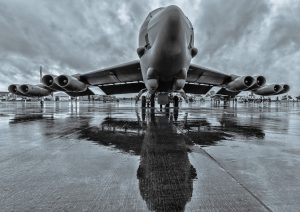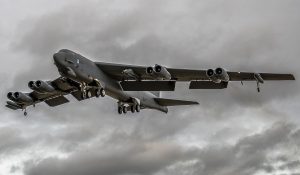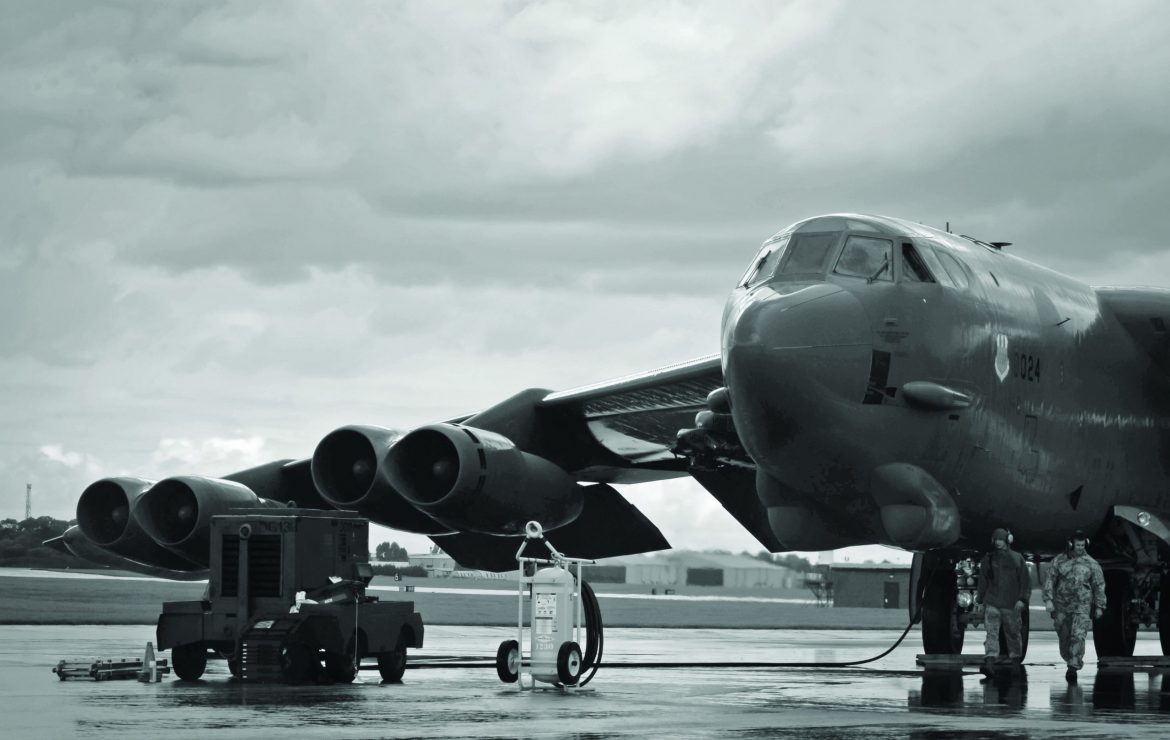There is an old adage that, if something is not broken, then do not attempt to fix it. We could perhaps add the idea that, if something is not broken and is going to cost a huge amount of money to replace, then definitely do not try to fix it. This appears to be the philosophy with the recently-announced series of enhancement programmes for the US Air Force’s Boeing B-52 Stratofortress long range bomber aircraft, popularly known as the Big Ugly Fat Fellow (BUFF).
Contracts announced over the last two years will see the modified B-52J (superseding the original B-52H) receive major enhancements to its radar, command-and-control communications, and weapons systems. A tender was also announced in 2018 for a Commercial Engine Replacement Programme (CERP), that would see the B-52J operating up to and probably beyond 2050. This would make the aircraft comfortably the longest continuously operating jet in history.
The heritage of the B-52 is impressive. Launched in the mid 1950s in the white-hot heat of the early Cold War, the aircraft’s early days were symptomatic of the infamous “bomber gap” miscalculation, in which the US was fooled into believing the Soviet production of the M-4 “Bison” strategic long-range bomber was far outstripping their own rates of production. President Eisenhower was sceptical, but ultimately sanctioned not only the launch of the U-2 programme, but an accelerated production of B-52s, of which 750 were eventually pressed into service. Ironically, the U-2 subsequently managed to dispel the myth of the bomber gap by spying on Soviet airfields.
Just over a hundred of the B-52H variants were manufactured in the 1961-63 period, and, at the start of 2010, an incredible 94 of these were still flying. The plan is to retire 18 of these aircraft by 2030, still leaving a very impressive fleet of functional military aircraft mostly over 70 years of age.

The B-52H is not particularly fast, cannot fly at particularly high altitude when heavily laden, or be flown against robust air defences. But its solid reliability, impressive range allowing for long dwell-time on target, and precision weapons systems have meant it has enjoyed a long stay of execution in the US’s military capability. It remains the only bomber that can launch nuclear cruise missiles, and can do so from some distance outside the range of enemy air defences. As a basically dependable, heavy-duty work-horse, the logic of adding increasing levels of sophistication to its frame has always made sense. Most of the existing aircraft continue to fly regularly from their main bases in Barksdale, Louisiana, and Minot Air Force Bases in North Dakota, but have often been deployed elsewhere in NATO regions, such as to RAF Fairford in the UK in 2020.
The original Cold War logic of the B-52 echoed British military thinking in the Second World War, that air defences alone were not enough to provide resilience against a major attack. Instead, it was calculated that an offensive bombing capability of one’s own would be the only effective deterrent. Of course, twenty-first century military conflict and air capability are not entirely like those of a hundred years previously. The modern airforce is increasingly comprising a complex range of aircraft, from small drones to fast fighter-jets, with all of these linked by highly sophisticated electronic C4ISR capabilities. With cutting-edge electronics deployed on its essentially reliable airframe, however, a continued role for the B-52 within the overall air disposition of the modern military is entirely logical for those powers that wish to project power at distance.
In 2018, the tender was announced for the CERP, to upgrade the B-52J’s engines with the best and most efficient 21st-century technology. The contract is potentially huge, not least as each of the aircraft has eight engines apiece. The contract award is due to be made in 2021, and the usual suspects of Pratt and Whitney, GE Aviation and Rolls Royce are currently in the running. Pratt is likely to be a front-runner, as the manufacturer of the original and current TF-33 engines used on the bomber. If the complications of hanging new engines on 60-year old airframes can be overcome, the project will give the B-52 a considerable new lease of life.
Other modifications to the aircraft come under an earlier umbrella $11.9 billion contract, and include a Radar Modernisation Programme (RMP). In July 2019, it was announced that Raytheon had been chosen to supply replacements to the Northrop Grumman radar system, beating the latter’s bid for a new Scaleable Agile Beam Radar (SABR). Raytheon’s recently announced Active Electronically Scanned Array (AESA) radar system allow the B-52 to locate more targets, with more accuracy, across a longer range, thus making the most of its cruise missile and advanced Rafael Litening and Lockheed-Martin Sniper weapons pods. The changes would require a new radome on the airframe, replacing the forward-looking television and infrared pods currently fitted under the nose.
Within the aircraft, the proposed Combat Network Communication Technology (CONECT) programme will update communications links, computers and visual displays, allowing for near real-time intelligence and command-and-control messaging using the very latest technology. This will include installation of NATO’s Link 16 communications channel to the aircraft, making it the last airframe of the fleet to receive this upgrade. Connectivity with naval platforms will also be facilitated by a new secure data link. Such upgrades would take the aircraft resolutely beyond the era of line-of-sight analogue communications on which it previously relied.
These modifications could allow for reductions in crew on the B-52s, especially if autonomous capability on some of the weapons systems can be further developed. This would deliver the perpetually-needed cost savings and automation central to military modernisation. It also brings the aircraft into line with the core requirements of the modern airforce operating in dynamic, multi-platform and rapidly developing scenarios, in which the B-52 would need to interact with the much newer and more sophisticated autonomous drones, F-35 fighter jets, and a range of other platforms on land, sea and air.
It goes without saying that the ability to receive and promulgate dynamic intelligence feeds and to be compliant with the highest levels of cybersecurity against hostile actors will also be central to the upgrades. This could include an upgrade to the bomber’s existing ALQ-172’s Electronic Counter Measures (ECM) capability. With that said, the primarily stand-off posture of the B-52 may mean such upgrades could be lower down the priority list.
On the weapons front, the B-52 was always the only aircraft outside of the Soviet Union that could launch long-range nuclear cruise missiles, making it the ideal platform for the proposed new Long Range Stand Off (LRSO) missile, due to replace the existing AGM-86B air-launched conventional or nuclear cruise missile. Last year, it was announced that the aircraft had also conducted some data-gathering test flights carrying the hypersonic AGM-183A Air Launched Rapid Response Weapon (ARRW).
On conventional weapons, upgrades to the internally-mounted rotary launcher should allow the B-52 to double the number of munitions it can fire at once from four to eight, without creating power problems.
All of these programmes connect with the existing Smart Weapons Next Generation Integration (SWING) contract on the B-52s. This project is not only about integrating new munitions and weapons systems on the aircraft, but developing a software interface (the Universal Armament Interface) that allows for easy integration of future weapons platforms.
Some estimates place the total bill for the modernisation of the B-52 at around $32 billion. This may seem like a considerable outlay, but is multiple times cheaper than developing and introducing a brand new, next-generation long range bomber that could compete with the B-52. The decision to continue modernising the old Cold War bomber is testimony to its unparalleled design and robustness.
Strategically, one could ask why – 30 years after the end of the Cold War – the US is still investing heavily in massive, state conflict-oriented capabilities such as a long-range bomber fleet with nuclear weapons. It is the case that the post- Cold War era has seen military strategizing moving towards more dynamic, fast-moving and regionalised military capabilities. Many of these are capitalising on opportunities offered by new technologies, particularly in the area of autonomous vehicles, which are generally much cheaper to build and operate than the “exquisite” massive talismans of the Cold War, such as the aircraft carrier, intercontinental ballistic missile or long-range bomber. It is also the case that most of the targets of concern in the modern era have been the sorts of lower-level, asymmetric or regionally state-sponsored insurgent and militia forces, against whom such massive capabilities are anathema.
However, the return of large, non-Western state powers such as Russia and China, and the massive investments they are making into superpower military capabilities, have meant that the old Cold War logic is still on the table for the US and its allies for the foreseeable future. China, for example, has been investing in recent years in the sort of deep-water naval capability, and airborne “nuclear triad” that characterises a major military power with plans to rival the US. Indeed, China introduced its own upgraded strategic long-range bomber in 2019 in the shape of the Xian H-6N. Based on the Soviet-era Tupolev TU-16, the new H-6 variant represents significant improvements on earlier versions that will see it at the centre of China’s strategic airborne defence capability for at least the next ten years. Integrating with its own Chengdu J-20 stealth bomber, and Sukhoi SU-35 fighter jet, the (Chinese) H-6N completes a strategic nuclear triad of not insignificant capability.
For these reasons, the imperative of maintaining a large and capable long-range, stand-off strategic nuclear capability is still central to military thinking in the US, both for itself and in the interests of supporting strategic allies and partners in areas such as the Gulf, and the Pacific region. In this aim, the US still feels very confident in turning to its trusty old friend, the B-52, for at least a few more years.

» By : Julian Richards, University of Buckingham BUCSIS













